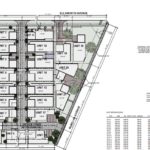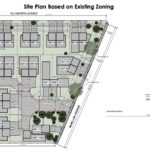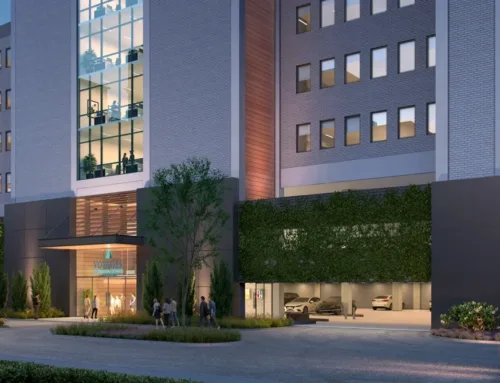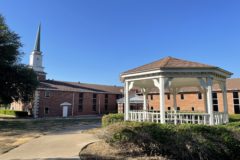
Mockingbird Community Church near Glencoe Park. Photo by Renee Umsted.
A residential development with 21 single-family units is proposed for the Ridgecrest Baptist/Mockingbird Community Church site in the Glencoe Park neighborhood.
Twenty-five people gathered Oct. 10 at the church at the corner of Ellsworth and McMillan to listen and query developer Mark Weatherford and District 14 City Plan Commissioner Melissa Kingston.
Weatherford is asking for a zoning change on the 1.82-acre site to build 21 single-family homes in a shared-access development. The project would be very similar to Weatherford’s project on Pine Tree Court. Developed in 2013, it is adjacent to Ridgecrest on land Weatherford purchased from the church a year before.
The corner site has a 75-year history of serving as a church in the Glencoe Park community. Current Pastor Greg Byrd says Ridgecrest was a “church plant” of Lakeside Baptist Church on Garland Road. Initially, a small group met in an M Street house until 1947, when the church acquired the acreage at Ellsworth and McMillan. The sanctuary that exists today was built in 1961.
Byrd says peak membership of the church was about 450 members in the 1970s. Like other churches in East Dallas, the congregation diminished in size as the neighborhood changed. In the case of Ridgecrest, the congregation began drawing Hispanic faithfuls, and when the bilingual Byrd arrived in 2012 from Mexico City, the congregation was 60%-70% Hispanic and numbered about 100.
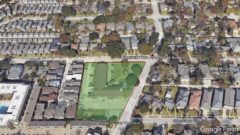
Map showing Mockingbird Community Church site. Courtesy of Baldwin Planning.
Seeking to grow the East Dallas Christian community, Byrd provided space for two other small but growing churches — Eastside Community Church and Christ City Church. At the same time, Byrd wanted Ridgecrest to be “a church of the community,” and it rebranded to Mockingbird Community Church, its current name.
In the ensuing years, many older members of the church died, and the nearby Hispanic community was displaced by younger, more affluent neighbors who didn’t speak Spanish. The inability to meet in person during the COVID-19 outbreak made it more difficult to gain any traction in growing the membership.
In 2020 and 2021, Byrd partnered with nonprofits Unite Greater Dallas , Services of Hope and Project Unity, offering up the Mockingbird Community facilities to serve as a hub for food distribution to local food banks and other service groups meeting needs during the pandemic.
Despite this difficult time, Eastside Community and Christ City grew their membership and moved to other facilities. Eastside now meets at Scofield Christian Church, and Christ City assembles at Lake Highlands Baptist Church.
The physical plant at Ellsworth and McMillan continued to deteriorate with little capital available to properly maintain the buildings. The church had dwindled down to 19 members and exhausted all financial resources they received when they sold real estate to Weatherford in 2012.
Right now, the building needs are overwhelming. The roof was installed in 1982, the electric installation is not up to current code, the sewer line has 200 feet of aged pipe that doesn’t flow properly, and the building is full of asbestos. The current insurer is unwilling to renew after Dec. 31 without an electric upgrade of $150,000.
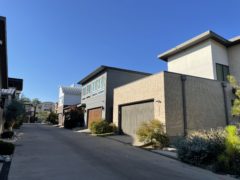
Pine Tree Court development. Photo by Renee Umsted.
The work to fix it all is in the millions, and Mockingbird Community Church made the heartbreaking decision to sell the property and end services after four generations. Weatherford had built trust and credibility with the church 10 years ago during the development of Pine Tree Court, so instead of identifying a real estate agent and listing the property, Byrd and Weatherford struck a deal. The property is now under contact with a closing contingent upon a successful rezone.
Although serving as a church since 1947, the property, like much of the real estate in this corner of Dallas, is zoned for duplex development. Weatherford thinks a better plan for his business and the neighborhood is a single-family project with shared access from a private street.
The wonky twist here is that a duplex zoning requires two units attached in one structure on a minimum 6,000-square-foot lot. Pine Tree Court version 2.0, like the original next door, will be detached, single-family homes on lots with a minimum lot size of 3,000 square foot. The smallest lot size for a single-family designation is a 5,000-square-foot lot, so the best path for Weatherford is to do what he did in his first development. He will pursue a multifamily zoning classification (MF-2(a)) and place deed restrictions on the property prohibiting multifamily uses. Seems odd to choose a multifamily zoning with deed restrict against multifamily, but that’s the zoning universe.
In the meeting, Weatherford’s zoning consultant Rob Baldwin presented a site plan for a Pine Street Court-like project and compared it to what a developer could do “by right” under the current duplex zoning. Depending on the layout, a duplex project could allow 22 units with three-story structures and 12 curb cuts on Ellsworth and McMillan. Compared to the proposed 21-unit, for-sale, single-family project with a two-story deed restriction and limited access from Ellsworth and McMillan, a for-rent duplex project with 22 units, three stories and more curb cuts looks ominous.
Changing from a church use for 75 years is difficult for many in the neighborhood, but as one attendee in the audience put it, the current duplex zoning is problematic and Weatherford’s proposal is “the lesser of two evils.”
- The proposed site plan includes 21 single-family units with limited access from Ellsworth. Courtesy of Baldwin Planning.
- The site plan for existing duplex zoning shows 22 units with many access points from Ellsworth and McMillan. Courtesy of Baldwin Planning.
Livable space in each unit ranges from 2,340 square feet to 3,036 square feet, and a 400-square-foot, two-car garage is attached to each one. Weatherford estimates pricing will be $1 million to $1.3 million. This brought some angst to the crowd as housing affordability is top of mind for city and citizens. Neighbor Camille Gilchriest challenged Weatherford, Kingston and other Glencoe Park neighbors about affordability of new home ownership at these prices and asked both Weatherford and Kingston for at least one unit that could be offered at a price considered affordable. Neither committed.
Questions pertaining to traffic, drainage and trees were posed by the neighbors. Kingston shared that she had spoken to city staff in charge of each discipline and felt comfortable with the project as proposed. Specifically on traffic, she noted that city staff had reviewed the plan and determined additional traffic would be “negligible,” and no traffic-management plan was necessary. Regarding the existing trees, Kingston said that the city’s arborist believes this plan “has the greatest chance to save the existing trees.”
Neighbor Martha Carlson immediately challenged Kingston on the tree issue, saying she had a certified arborist review the plans and the existing trees and came to a much different conclusion.
Kingston wrapped the meeting by stressing her support for neighborhood self-determination. Asking for a show of hands in favor, a majority of the crowd raised their hands. She shared her inclination to support Weatherford’s proposal for several reasons:
- Fewer curb cuts
- Two story limitation
- More potential for short-term rentals with the by-right duplex plan
- Provision for guest parking
- Options for the immediate corner including a pollinator garden, flower plantings, vegetable gardens, bird sanctuary
A meeting of the City Plan Commission to review and vote on the project is not currently scheduled but will likely happen in the next few months. The City Council will then hear the case, consider the plan commission recommendation and take the final vote. Interestingly, current District 14 Council member Paul Ridley was on the plan commission when Pine Tree Court came before the commission in 2012 and voted to approve the development.
Byrd says Mockingbird Community Church’s 19 members will vote on how to distribute 100% of the proceeds to other ministries.
“Our desire is that out of the ashes and death of this local church, new churches and ministries will be born or rebirthed,” Byrd says. “The greatest effect Mockingbird Community will have will be on the future. I really don’t care if anyone ever remembers me, but that years from now people say this, whatever this is, would never have happened except for the gift years ago from Mockingbird Community Church.”
Editor’s Note (Oct. 13 at 1:45 p.m.): A previous version of this story misstated the size of each unit. The change reflects the living space of each unit, which ranges from 2,340 square feet to 3,036 square feet.

